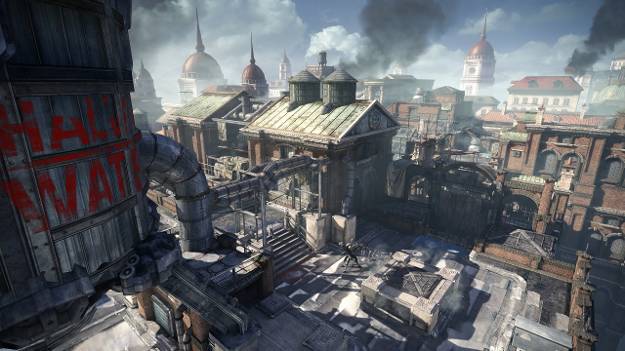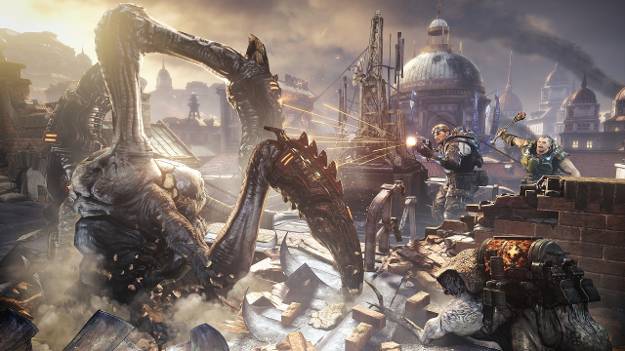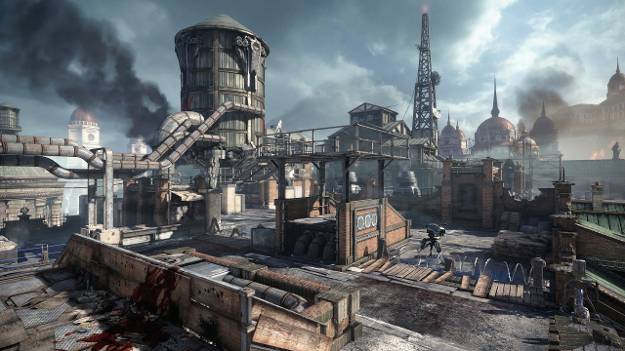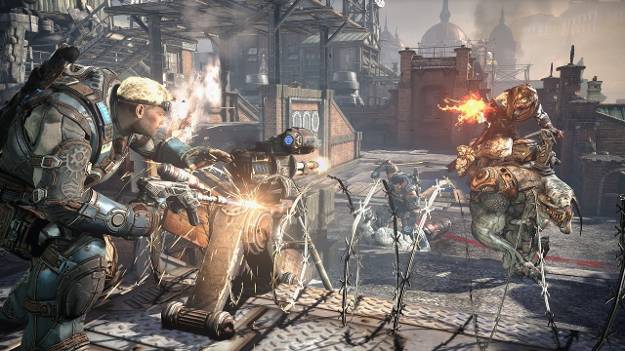When Gears of War 3 ended on its rather bleak but somewhat upbeat final cut scene, it really felt like the series had reached its end. Unlike the Halo series, which felt like there was perhaps unfinished business that could be used to make further games, it really did feel like the Gears of War games left almost no room for further adventures. The Locust race was gone, the Lambent were dust and the almost obliterated human species was on the cusp of being able to rebuild. So where do you go from there?
Nowhere apparently.

Gears of War Judgment is a prequel to the main series of games. Taking place shortly after the Locust started attacking the surface Delta squads’ irrepressible engineer Baird, currently a lieutenant in charge of Kilo squad, ends up stuck dealing with one of the first major Locust threats. With his longtime friend Cole, UIR sniper recruit Garron Paduk and Onyx Guard Cadet Sofia Hendricks Baird has to come up with some way to stop this threat, a Theron Guard named Karn. Most of the story is told as a flashback, testimonies being given by the Kilo squad members during an impromptu military trial, and the way the plot pans out is as by the books as it gets down to a stupidly aggressive military leader who learns to respect Kilo squad by the stories end.
Much of the narrative structure of this game is incredibly similar to the first Gears of War title. Almost a little too similar actually. You spend the first third of the game simply trying to repel the Locust and survive, the second third hopping around to gather the components to a weapon that will stop Karn and the final third actually doing the stopping with lots of explosions along the way. This parallels the first games search for the Resonator, gathering the data from the Fenix Estate and then the final battles to get to, and deploy, the bomb while also stopping RAAM to such a degree that it almost feels far too predictable.
Mind you, predictable can be fine in its own way. Not every game that comes out needs to reinvent the wheel but what we’ve got here is so derivative it actually kind of goes into hackneyed territory. To start with the characters are just written horribly. Baird’s only personality is “leader” and is missing most of his snarky attitude that makes him so fun and Cole is almost entirely quiet. The loud, boisterous guy is reduced to the occasional quip and that’s about it. The new characters are even worse since Paduk is the foreigner who dislikes the COG and that’s about it while Sofia is the by-the-books girl and… that’s it. With one-note characters and a bland story the plot is almost nothing but an excuse to move the characters along.
The other problem with this plot is that the game manages to feel like its dragging on for far too long while also being a fairly short game. If you’re good the whole thing takes about six to seven hours, including the short Aftermath scenario which takes place during the events of Gears of War 3. But in those seven hours you’re constantly doing the same things to the point of utter repetition. Gone are the world spanning adventures of Gears 2 and 3, now we’re back to ruined city, ruined city and more ruined city with a rip-off of the Invasion of Normandy the series had so far avoided.
Part of the problem with how stretched out the game feels likely comes from the arcade game feel the campaign has to it. Where the previous Gears games tried to foster a sense of dread with enemies who could emerge almost anywhere, Judgment goes for a more generic feel. Instead of the large sweeping levels where you could be attacked at any time these levels are instead broken up into small, bite-sized “segments” that have a pretty definitive beginning and end.

On the one hand these segments give you a pretty good point of focus. The mission starts, you pick up the nearby equipment, choose whether or not to activate the nearby Declassified Objective (optional mission objectives that make levels harder) and then proceed through a combat zone or two before moving on to the next level. This lets you play for a little bit at a time and still feel like you’re making progress especially since you’ll likely have to replay segments to earn all three stars to unlock some bonus content.
Unfortunately it also makes it feel like the game takes longer, everything being broken up by load screens and separate zones gives the experience this drawn out feel. This is made worse by the fact that neither cut scenes nor in-game dialogue really seem to advance the “plot” so the whole thing just feels like a massive drag. I don’t know that I’ve had a seven hours pass so obscenely slow in my entire life. This is the opposite of Gears of War 3 which were the shortest ten hours of my life.
The combat still manages to be the high point of the title since, by and large, it’s quite competently done. All of the usual Gears of War tricks are here although some new weapons, grenades and enemies have been added to the mix to spice things up. None of these are really standout except in the multiplayer gameplay (more on that later) although the Rager enemy does make fights more intense. These guys act like mini-Berserkers, they go from scrawny gun-wielding foes to spike-covered brutes that tear your allies apart in a few melee swipes.
What really highlight the combat are the set-pieces. A few of these are intense, skin of the teeth encounters against a variety of enemies that work well in messing up your face but the highlight are definitely the hold-the-line segments. In these you have a certain amount of time to set up defense turrets, stock up on weapons and ammo, plant grenade mines and then beat off the waves of enemies who assault your position. On Insane difficulty these sections are some of the hardest moments in any Gears of war game, especially with the Declassified objectives activated, and they’re totally awesome.
Unfortunately that fun is marred by how poorly balanced the gameplay feels at times. Even on Normal difficulty the Locust each apparently carry a bunch of grenades that they love nothing more than flinging at you. It almost feels like playing Call of Duty on Veteran difficulty – the grenade fun never stops and it gets really aggravating after a few levels. Many enemies can down you in one or two hits with their power weapons (or flat out kill you on Insane difficulty) so you’ll end up reloading a whole lot of what feel like obscenely cheap deaths.
This isn’t helped by the fact that the AI in this one feels rather… well, rather stupid. They were almost suicidal in the first game, smarter in the second and beyond aggressive in the third but still able to take care of themselves. But here they’re aggressive enough that they spend a lot of the time charging enemies only to end up downed and then another ally will run over to them and promptly get downed. It’s clear the game wanted you to have three other players alongside you but this issue can bite you on the bottom even if you’ve only got one AI partner which is a real pain.

Frankly a part of me can’t help but feel like I’m playing Bulletstorm all over again instead of Gears of War, what with the scoring system and focus on grand, chaotic encounters as opposed to a persistent threat that could come at any time. This gives the game a bizarre, structured feel to the encounters that’s just entirely at odds with what I think of when I think of Gears of War.
As usual a lot of attention was paid to the multiplayer but unfortunately it’s by and large not good news. The new weapons that were added have a mild impact on the campaign but in multiplayer they only add to the frustration. Everyone still uses the Gnasher in all of its overpowered glory but rather than using the Longshot, and its vastly limited ammo, they simply use the Breechshot for its one shot kill capabilities and larger ammo carrying capacity. Frankly since all anyone uses is the Gnasher and Longshot anyways this change is… baffling to say the least. The learning curve for any newer players looking to get into the series is so steep that it’s almost not even worth bothering. They might as well go play the second or third game – they’re cheaper to buy and the imbalances aren’t quite as bad.
Another bizarre and somewhat aggravating change is that of Survival Mode. Horde Mode has been excised, only to be replaced by Survival which is kind of like a watered down imitation. You pick one of four classes, each with their own abilities and weapon load out and each has its own set avatar. So pick the Engineer and you’ll look like Baird, get a shotgun, repair tool and the ability to set sentry turrets while Snipers look like Paduk, get a Marzka semi-auto sniper rifle and can climb to higher ground most other enemies can’t access. Then you have to survive ten exceedingly long waves of enemies while defending three different objectives, two E-Hole covers and a Hammer of Dawn generator. If one is destroyed you fall back to the next until you’re defending the final generator which causes the game to end if it’s destroyed.
While this sounds alright, that’s all it really is – alright. Horde mode in Gears of War 3 was a much more compelling experience with the boss waves, leveling up your ability to plant fortifications and earning money to use the fortifications by performing well. Here your only goal is survival, you gain nothing besides XP and it’s actually kind of boring. It’s interesting to see how devastating a team of five players can be, working together and just mowing down wave after wave of Locusts but that’s only fun for a very short while. Perhaps that’s why there’s such an immensely limited selection of maps for this mode. Either that or they plan on selling more to us shortly after release.
The only innovation to be found here in the online modes is OverRun which is basically Survival mode except both sides are player controlled. The COG operates almost exactly the same as they are in Survival even down to defending the three objectives. The Locust though, they operate almost exactly like they do in Gears of War 3’s Beast mode and are amazingly fun to play. You don’t have access to Berserkers, Grinders, Boomers or Armored Kantus troops anymore but the Rager and new, more effective Corpser definitely make up for that.

Out of all of the game modes available in Judgment this is almost certainly where the majority of attention went. The campaign acts are lackluster, the regular versus modes are the same old, same old and Survival is a poor man’s Horde mode. OverRun is the only mode that’s any sort of fun but even then it suffers from the same problem as the multiplayer in general does – it’s far too easy to kill most Locust. They’ve tried to make up for this by making most basic Locust, namely Tickers and the Kantus, free of charge. This lets you focus on saving up for situational Tier II Locust like the Serapede or Rager and overcomes the squishy nature of PvP.
One of the oddest changes is the way that the men have been slimmed down. Previously the Gears were so bulky they almost appeared to be genetically enhanced super soldiers instead of normal humans. But here they’ve been slimmed down to human proportions which look kind of bizarre after three games. Luckily that’s the only complaint that can be leveled at the look of the game since otherwise the game looks absolutely fantastic. Whether talking about the character models, the backgrounds or the utter destruction that happens when a massive explosion occurs the graphical fidelity always remains high.
Normally the music isn’t something I actually notice in a Gears of War title, barring the “Mad World” instrumental in the third game, but here it’s actually quite well done. The musical accompaniment to each scene is spot on, catching the mood quite nicely. Out of all the games in the series this game is the only one that has a soundtrack that I can see myself listening to when not playing the game. The voice acting is above par as well whenever they actually give the voice actors something of substance to say. This doesn’t actually happen very often.
Gears of War Judgment is one of those games that really just didn’t need to happen. It’s almost like someone had an interesting idea for a new multiplayer mode, then found some excuse to wrap a game around it so they could sell it as a full price game. It actually reminds me of what happened with Halo: ODST except that I enjoyed the film-noir atmosphere of ODST whereas Judgment has nothing even remotely that clever working in its favor. If you’re getting it, get it for OverRun otherwise you can basically pass on this one.